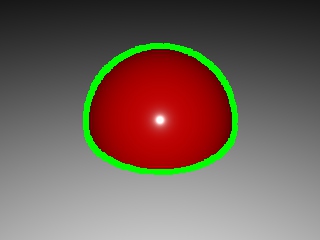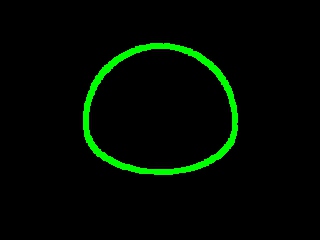Create a complex imager - Arnold Developer Guide
Object outline imager
In this example, we will create a slightly more complex Imager that draws an outline of pixels of a given color around the border of objects in the render. Please be sure to check out Create Simple Imager before trying this example.
In this example, we use the optional imager_prepare API to set up additional resources required in our imager_evaluate stage. First, we tweak the schedule type of the Imager to be AtImagerSchedule::FULL_FRAME. This changes the scheduling of the imager so that it receives the full frame of pixels of the render, rather than individual buckets of pixels. This is so that our algorithm can search neighbouring pixels. Secondly, we add the object AOV as an input so that we can access it with AiImagerAddInput() during imager_evaluate.
We use the object AOV at evaluation time to determine which objects lie in which pixels and thus, find the object edges.
Finally, we use the AiImagerAddOutput() API to create an additional output to our driver. We use this additional output as a place to write just our edge pixels.
See Creating a Simple Plugin for further information about compiling the imagers.
complex_imager.cpp
#include <ai.h>
AI_IMAGER_NODE_EXPORT_METHODS(ImagerMtd);
node_parameters
{
AiParameterNode("filter", nullptr);
AiParameterRGB("color", 0.f, 1.f, 0.f);
AiParameterFlt("blend", 1.f);
AiParameterUInt("radius", 3);
}
node_initialize
{
}
node_update
{
}
namespace
{
static AtString filter_str("filter");
static AtString rgba_str("RGBA");
static AtString obj_str("object");
static AtString closest_filter_str("closest_filter");
static AtString color_str("color");
static AtString blend_str("blend");
static AtString radius_str("radius");
static AtString edge_str("edge");
}
imager_prepare
{
// Set the imager schedule type to full frame always as we need access to all
// neighbouring pixels
schedule = AtImagerSchedule::FULL_FRAME;
AtNode* filter = (AtNode*)AiNodeGetPtr(node, filter_str);
if (!filter)
AiMsgError("No filter set!");
if (AiNodeEntryGetNameAtString(AiNodeGetNodeEntry(filter)) != closest_filter_str)
AiMsgError("Imager requires closest_filter!");
// Request the object AOV to be accessible to the imager at evaluation time
AiImagerAddInput(render_session, node, driver, AI_TYPE_NODE, obj_str, filter);
// Also add another output for us to write just our outline to
AiImagerAddOutput(render_session, node, driver, AI_TYPE_RGBA, edge_str);
}
imager_evaluate
{
AtRGBA* rgba = nullptr;
AtRGBA* edge = nullptr;
AtNode** obj = nullptr;
int aov_type = 0;
const void *bucket_data;
AtString output_name;
// Iterate over the outputs and grab pointers to the ones we need
while (AiOutputIteratorGetNext(iterator, &output_name, &aov_type, &bucket_data))
{
if (output_name == rgba_str)
rgba = (AtRGBA*)bucket_data;
if (output_name == edge_str)
edge = (AtRGBA*)bucket_data;
if (output_name == obj_str)
obj = (AtNode**)bucket_data;
}
if (!rgba || !obj)
{
AiMsgError("Failed to find all required outputs");
return;
}
AtRGB color = AiNodeGetRGB(node, color_str);
float blend = AiNodeGetFlt(node, blend_str);
const int radius = AiNodeGetUInt(node, radius_str);
const int radius2 = radius + radius;
// Iterate over our framebuffer of pixels
for (int y = 0; y < bucket_size_y; ++y)
for (int x = 0; x < bucket_size_x; ++x)
{
int idx = y * bucket_size_x + x;
AtNode* curr_obj = obj[idx];
if (!curr_obj)
continue;
bool is_edge = false;
// Check our neighbourhood window and compare object pointer to detect if
// our pixel is near an edge.
for (int i = 0; i < radius2; i++)
{
for (int j = 0; j < radius2; j++)
{
unsigned int sub_x = AiMin(AiMax(x - radius + i, 0), bucket_size_x -1);
unsigned int sub_y = AiMin(AiMax(y - radius + j, 0), bucket_size_y -1);
int sub_idx = sub_y * bucket_size_x + sub_x;
if (curr_obj != obj[sub_idx])
is_edge = true;
}
if (is_edge)
break;
}
// If our pixel is an edge pixel, write our color to our RGBA and edge outputs
if (is_edge)
{
rgba[idx] = AiLerp(blend, rgba[idx], AtRGBA(color,rgba[idx].a));
edge[idx] = AtRGBA(color, blend);
}
}
}
node_finish
{
}
node_loader
{
if (i>0) return false;
node->methods = (AtNodeMethods*) ImagerMtd;
node->output_type = AI_TYPE_NODE;
node->name = "complex_imager";
node->node_type = AI_NODE_IMAGER;
strcpy(node->version, AI_VERSION);
return true;
}complex_imager_example.ass
options
{
AA_samples 3
GI_diffuse_depth 0
outputs "RGBA RGBA filter out"
}
persp_camera
{
name persp
position 5 5 5
look_at 0 0 0
up 0 1 0
fov 54
shutter_start 0
shutter_end 1
}
box_filter
{
name filter
}
closest_filter
{
name myClosestFilter
}
complex_imager
{
name imager
filter myClosestFilter
}
driver_exr
{
name out
filename complex_imager.exr
tiled false
input imager
}
standard_surface
{
name myshader
base 0.8
base_color 1 0 0
}
standard_surface
{
name myshader_ground
base 0.8
base_color 1 1 1
}
point_light
{
name mylight
position 5 5 5
intensity 100
color 1 1 1
}
plane
{
name __ground__plane__
point 0 0 0
normal 0 1 0
shader myshader_ground
}
sphere
{
name sphere0
center 1 1 POINT 0 0 0
radius 1 1 FLOAT 2
shader myshader
}

